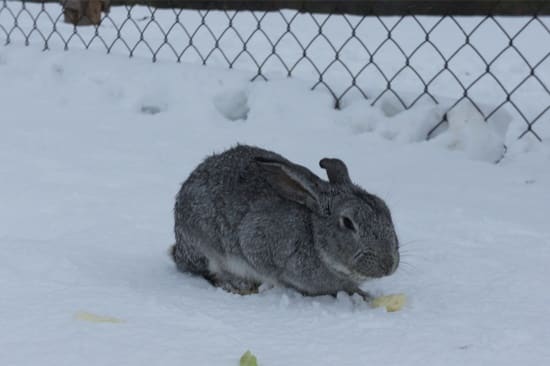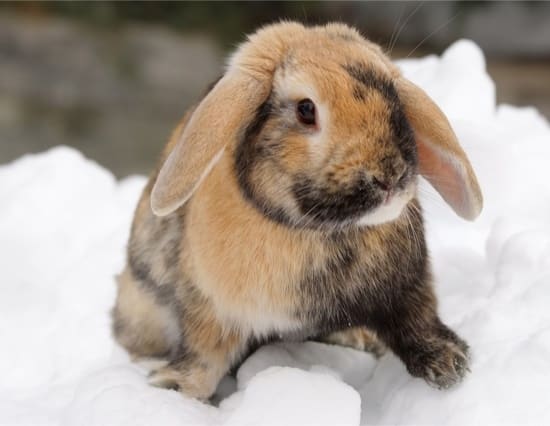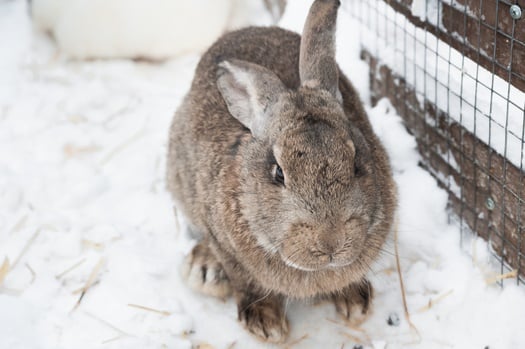Rabbits often live outdoors, and they’re content this way. It can feel cruel to leave rabbits outside during the winter months, though. It’s only natural to worry about your bunny staying safe during the winter season. When the temperature drops and the wind is icy, they are surely freezing.
Rabbits thrive in cold temperatures. They cease shedding during the fall and grow thick fur that keeps them warm in the winter. They’re comfortable in temperatures as low as 32 degrees Fahrenheit.
Moving a rabbit indoors during the winter is riskier than leaving them outside. A sudden change in temperature can harm a rabbit. It’s best to insulate their hutch and regularly monitor their temperature. We’ll explain how to keep your rabbit safe and comfortable throughout the winter.
What Temperature is Too Cold for Rabbits?
Despite their frail appearance, rabbits are quite hardy when it comes to dealing with cold weather. A rabbit would always rather be chilly than too hot.
The average body temperature of a healthy rabbit is between 101-103 degrees Fahrenheit. This can be sustained in outdoor temperatures of 32 degrees Fahrenheit, and even slightly lower.
Check your rabbit’s body temperature regularly throughout the winter. If it remains above 101 degrees Fahrenheit, they’re fine. If it drops to 100 degrees Fahrenheit or below, your rabbit is hypothermic. This requires action.
What are the Symptoms of Hypothermia in Rabbits?
It’s pivotal that you understand the warning signs of hypothermia in rabbits. Aside from body temperature, Vetstream describes the symptoms as follows:
- Cold extremities, such as the tips of the ears and the paws
- Coolness to the touch, and a pale appearance
- Uncharacteristic lethargy. Most bunnies are more active in cool temperatures
- A weak and unsteady heartbeat
- Shallow breathing
- Lack of coordination, and potential loss of consciousness
It’s crucial that you check your rabbits regularly during winter. If they display warning signs of hypothermia, they’ll need treatment.
You can rouse your rabbit from a hypothermic state at home. You’ll need to act quickly, though. Hypothermia can become lethal in a matter of hours.
How Can Hypothermia in Rabbits be Treated?
Treating a hypothermic rabbit is comparatively simple. You need to warm them up quickly.
Wrap your bunny in a thick towel or blanket, and bring them into your home. Once you’ve done this, increase their body temperature. There are two simple techniques for this:
- Fill a hot water bottle, and let your rabbit lie upon it
- Place a towel in the microwave for 30 seconds. Repeat this until the towel is warm, but not hot enough to burn your rabbit. Wrap the bunny in the warm towel
A hot water bottle is faster to prepare. Alas, when the bottle starts to cool it extracts heat from your rabbit’s body. Check the hot water bottle every thirty minutes, replacing the water where necessary.
The towel technique takes a few minutes to arrange. This may be a time that your rabbit doesn’t have. It gets quick results though, rapidly warming your bunny through. If you have the time to spare, this technique is recommended.
When your pet’s body temperature returns to 101 degrees Fahrenheit, they’re out of danger.
Can Rabbits Live Outside All Year?
This depends on where you live, but rabbits will seek shelter in the winter. Extremely harsh winters are dangerous to any animal, including rabbits. Most rabbits relish a cooler climate, though.
You will surely notice that your rabbit stops shedding during the fall. This is a natural survival mechanism. Your bunny is growing a thick winter coat, which keeps them warm throughout the winter.
One exception to this rule is young rabbits. Until they reach six months of age, bunnies still have their baby fur. This will not offer sufficient protection from extremely low temperatures. Young rabbits should stay indoors during winter.

You may also notice that your rabbit desires more exercise during the winter. This is natural. Rabbits become more playful when the temperature drops.
Allow your rabbit to run and play in your yard during the winter. Just be careful about getting their fur wet. A bunny’s body temperature can drop sharply if they are wet through.
If your rabbit gets damp, dry them off with a heated soft towel. Don’t return your bunny to their home until their temperature is a stable 101 degrees Fahrenheit.
Keeping Rabbits Warm in Winter Outside
You can take several steps to keep outdoor rabbits stay safe throughout the winter. These include:
- Ensure that your rabbit’s hutch has a reliable, dry and secure roof.
- Insulate your rabbit’s hutch. This will keep the interior warm and dry.
- Place a cover over the door to your rabbit’s hutch. This prevents cool air from blowing in.
- Provide a cardboard box filled with hay. Your rabbit will use this as a separate, warmer bedroom.
- Ensure there are no direct draughts in your rabbit’s home. You must still allow air to circulate, though. Stifling a rabbit in a stuff environment is just as dangerous.
- Regularly check your rabbit’s water, making sure that it has not frozen. If necessary, offer your bunny hot chamomile tea to warm them up.
- Check your rabbit’s litter tray regularly. Ensure that urine is not freezing and creating a strong ammonia scent. Equally, make sure your rabbit does not have frozen urine on their fur.
- Clean your rabbit’s hutch during the winter. Straw and hay become damp in cold conditions.
- Increase your rabbit’s food intake a little during the winter months. They will burn more energy staying warm. Don’t panic about their weight as they’ll also exercise more.
- Add a heat lamp or heating pad to your rabbit’s hutch to increase the base temperature.
- If you have two bonded bunnies and a large enough enclosure, house them together. They will share body heat and provide mutual warmth.
Outdoor Insulated Rabbit Hutches
Insulation is key to keeping rabbits warm during the colder months. This can be achieved in several ways.
The least laborious way is to purchase an insulated hutch from a pet store. This will be expensive, though. There are several ways that you can insulate a hutch yourself. These include:
- Placing tarpaulin over the hutch overnight, when the temperature is lowest
- Covering the hutch with old blankets or towels. Just avoid blocking the flow of fresh air
- Surrounding your rabbit’s home with windbreaks
- Applying thermal insulation foil to the hutch, ideally outside
Every little helps when insulating a rabbit’s hutch. Just remember, rabbits struggle with the heat. Don’t take insulation too far if your winters are mild.
Rabbit Hutch Covers
One of the best ways to keep a rabbit warm in winter is to cover the door to their hutch. This will prevent cold winds blowing throughout a rabbit’s home.
Clear Perspex is ideal for this. This material will keep your rabbit warm, but still allow them to see out. No bunny will enjoy being enclosed in a hutch without a viewing station.
Another advantage of covering the door of your rabbit hutch is safety. During the winter, predators are hungrier and will go to more effort to hunt. This means they can tear through the wire of a bunny’s hutch. Perspex keeps them out.
Heat Lamps for Rabbit Cages
There are two primary problems with heating lamps in a rabbit hutch. Firstly, they need a power source. This means cables in your rabbit’s hutch, and the likelihood of these wires being chewed.
The second problem is the potential for your rabbit overheating. If a rabbit’s body temperature rises above 103 degrees Fahrenheit, they’ll be uncomfortable. This can lead to stress.
One way around this is to place the heating lamp outside the hutch. Just make sure it does not shine straight onto wood, as this is a fire hazard. Regularly check for burned-out bulbs, too.
An alternative to heating lamps is heating pads. Heat these in the microwave, and place them on the floor of your rabbit’s home. This provides wire-free warmth for up to ten hours.
Preventing Rabbit Water Bowls and Bottles from Freezing
Maintaining access to water is another central element of rabbit care during winter. If your bunny’s water freezes, they’ll struggle to stay hydrated.
If your rabbit’s water bowl is floor-based, ensure the bottom of the hutch is warm. The heating pads that we just discussed are helpful for this.
Also, consider switching bowls for bottles. These can be fastened to the side of a hutch. You could wrap these bottles in a sock or glove to maintain warmth, too.
Bedding for Outdoor Rabbits
Make your rabbit an appealing bed during the winter months. Your rabbit will welcome a particularly cozy corner to sleep in that consists of the right type of bedding.
The easiest way to achieve this is by placing a cardboard box in your rabbit’s home. Fill this box with straw or hay, and consider applying blankets. This will become your rabbit’s nest throughout the winter.
As rabbits sleep for 8 hours at a time, this is important. Their body temperature will drop during this time. If they have a toasty nest, they can doze in comfort.
Should I Bring My Rabbit Inside During the Winter?
Alternating a rabbit between indoors and out can be dangerous. Bunnies struggle with sudden temperature changes. If they lurch from cold to hot, their bodies go into shock.
If the temperature drops below 30 degrees Fahrenheit, consider moving your bunny indoors. Try our warming tips on their hutch first, though.

The best indoor location for a rabbit in winter is a shed or garage. These locations offer protection from the elements, without growing stiflingly warm.
If your rabbit maintains a constant temperature, keep them inside until the weather improves. Ensure they still enjoy regular exercise, in or out of the house.
You’ll also need to make sure the location is pet-safe. Perform a risk assessment. If your rabbit escaped their hutch, would they encounter dangerous chemicals or tools? If so, remove these items.
How to Keep a Bunny Warm Inside
Once your rabbit is shielded from the wind and rain, they’ll typically keep themselves warm. You should not need to take additional action.
You shouldn’t increase the central heating. This can cause a rabbit to overheat. Keep their temperature consistent at 101-103 degrees Fahrenheit.
If you do need insulation while your rabbit is indoors, use newspaper. This is less likely to create a stifling atmosphere than anything thicker.
Ensure the newspaper uses an edible, soy-based ink. Some newspapers use cheaper ink, which can be toxic to rabbits if they eat it.
How Do Wild Rabbits Stay Warm in the Winter?
Wild rabbits don’t benefit from the help of human owners in the winter. How do these bunnies stay safe and warm?
In many respects, wild rabbits are similar to domesticated pets. While their hutch shelters your bunnies, wild rabbits build warrens as far underground as possible.
This shields them from harsh winds, rain and dropping temperatures. Wild rabbits emerge to exercise and eat. Once the weather turns again, they’ll go back underground.
Wild rabbits also live in groups. This means that there will always be another bunny on-hand to share body heat. This, coupled with their thick winter fur, keeps the animals warm.
If you spot bunnies on your property during winter, you may be tempted to help them. This is inadvisable. Wild rabbits manage their needs by themselves. If they become reliant on humans, it dulls their survival instincts.
Ensure your pet is fed, exercised and safe. This, along with plenty of company, ensures their happiness. Only bring them inside if strictly necessary.

